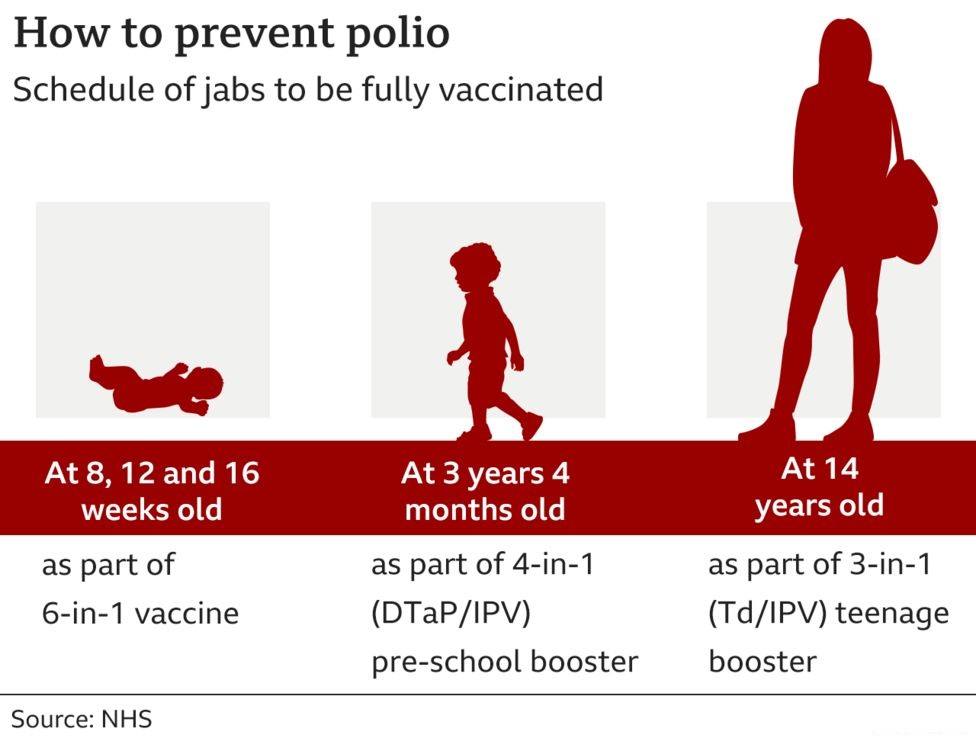Polio can be a serious infection, caused by a virus which spreads easily through contact with the faeces (poo) of an infected person or less commonly through droplets when they cough or sneeze.
It mostly affects children under five years old.
The majority of people with the infection have no symptoms but some feel like they have the flu with:
- a high temperature
- sore throat
- headache
- stomach pain
- aching muscles
- feeling sick
A small number of infected people - between one in a thousand and one in a hundred - develop more serious problems where polio invades the nervous system. This causes paralysis - usually of the legs.
This is not normally permanent and movement often comes back gradually.
But it can be life-threatening - particularly if paralysis affects muscles used for breathing.
What age do you get the
polio vaccine?
The UK used to use a highly effective oral polio vaccine that came as drops. It has switched to the newer, injectable form.
The NHS offers five doses from the ages of 8 weeks to 14 years as part of routine childhood jabs.
How to prevent polio
People need to have all of these vaccinations to be fully immunized against the disease.
You can have a vaccination at any point if you've never had one before.
How can you protect
children?
In the UK you can check your children's red books to make sure they are up-to-date with their routine jabs. Contact your GP if one has been missed.
Health officials say the first three jabs, given to young babies, offer good protection.
But take-up of the first three doses is about 86% in London, well below target levels, with the rest of the UK at over 92%.
This may in part be down to some populations in the capital moving regularly, making it harder to access vaccines at the right time.
Figures for 2020/21 suggest some 34,000 children aged five in London had not received their fourth jab
Most of the UK population will be protected from vaccination in childhood, but in some communities with low vaccine coverage, individuals may remain at risk.
Is polio a problem worldwide?
Cases have decreased by more than 99% since 1988, from an estimated 350,000 cases in more than 125 countries then to 175 reported globally in 2019.
All continents, except Asia, have been
certified as polio free.
The last person recorded to have acquired the wild virus in the UK was in 1984.
There are a few countries where the disease is still found - it includes war-torn Afghanistan and Pakistan, where it has been difficult to vaccinate everyone.
Globally, 83% of infants had received three doses of polio vaccine in 2020, according to the World Health Organization.
Are there different
kinds of polio?
Wild poliovirus is the most commonly known form.
But there is another, rarer type linked to the oral form of the vaccine.
The vaccine offers excellent protection against wild polio, is easy to use and has been deployed by many countries around the world - keeping millions of people safe.
However, it contains a weakened, live form of the virus which can replicate harmlessly in the gut. But that means some is then excreted in poo.
In rare cases, this weakened form can spread to unvaccinated people.
Over a long period the vaccine-derived virus might change to become more like wild polio.
Many industrialised countries now use the newer injectable form which contains a killed version of the virus.
Both vaccines are safe and effective.
In the last decade - a period during which more than 10 billion doses of oral polio vaccine were given worldwide - vaccine-derived-polio virus outbreaks resulted in fewer than 800 cases.
In the same period, in the absence of vaccination with the oral polio vaccine, more than 6.5 million children would have been paralysed by wild poliovirus.
Why is the polio virus
back?
A tiny number of samples of the polio virus are detected each year in the UK during sewage surveillance. However, this is the first time that a genetically-linked cluster has been found repeatedly over a period of months.
The polio virus detected in London most likely came from someone who had recently received an oral polio vaccine.
They will then have shed the weakened vaccine virus in their stools.
It is likely it was then passed on to another person at this point and has since infected some others. None have sought medical help though.
How much of a problem is
it?
The UK is so far taking the right approach, according to Sir Jeremy Farrar, director of the Wellcome Trust.
"It's a credit to the surveillance systems, it's a credit UK Health Security Agency for picking this up and then taking the right public health approaches."
And Prof Paul Hunter, professor of medicine at UEA, said while the findings were a concern getting more people vaccinated would help stop the virus.
Is polio still alive
today?
The United States has been polio-free since 1979, thanks to a successful vaccination program. However, poliovirus is still a threat in some countries. Get your child vaccinated on schedule to help keep the U.S. polio-free.
What was the real cause of
polio?
Polio is caused by 1 of 3 types of the poliovirus. It often spreads due to contact with infected feces. This often happens from poor handwashing. It can also happen from eating or drinking contaminated food or water. Polio is caused by 1 of 3 types of the poliovirus. It often spreads due to contact with infected feces. This often happens from poor handwashing. It can also happen from eating or drinking contaminated food or water. It can also be spread when an infected person coughs or sneezes infected droplets into the air. Those with the virus can excrete the virus in their stool for several weeks. People are most contagious right before symptoms start and soon after they appear.
What are the symptoms of polio?
Symptoms of polio vary in their severity. Most affected people have no symptoms at all. This is called an inapparent infection. The other types of polio are abortive, nonparalytic, and paralytic.
The following are the most common symptoms of polio. But each person may have different symptoms.
Abortive polio
Abortive polio is a mild and short course of the disease with 1 or more of these symptoms:
- Fever
- Decreased appetite
- Nausea and/or vomiting
- Sore throat
- Not feeling well all over (malaise)
- Constipation
- Abdominal pain
Nonparalytic polio
The symptoms for nonparalytic polio are like abortive polio. The infected person may feel sick for a couple of days. Then, they may seem to improve before getting sick again with these symptoms:
- Pain of the muscles in the neck, trunk, arms, and legs
- Stiffness in the neck and along the spine
Paralytic polio
The symptoms for paralytic polio are like the other 2 types. Plus, these symptoms may happen:
- Muscle weakness all over
- Severe constipation
- Muscle wasting
- Weakened breathing
- Trouble swallowing
- Muscle paralysis (may be permanent)
- Drooling
Where is polio still found today?
Only two polio-endemic countries (nations that have never interrupted the transmission of wild poliovirus) remain—Afghanistan and Pakistan. Without our polio eradication efforts, more than 18 million people who are currently healthy would have been paralyzed by the virus.
How is polio diagnosed?
Along with a complete physical exam and medical history, these tests may be done:
- Cultures of the throat and stool are most commonly used.
- Blood levels or cerebrospinal fluid testing is less commonly used.
How is polio treated?
Treatment will depend on your symptoms, age, and general health. It will also depend on how severe the condition is.
A vaccine can prevent polio, but there is no specific treatment for people who become infected. Treatment is focused on easing symptoms. Supportive measures include:
- Pain relievers, such as acetaminophen or ibuprofen
- Healthful diet
- Minimal activity
- Hot packs or heating pads for muscle pain
What are possible
complications of polio?
The most severe complication of polio is paralysis. This can lead to problems with breathing, swallowing, and bowel and bladder function.
Post-polio syndrome can happen many years after the initial infection. This syndrome causes:
- Muscle weakness and shrinking of the muscles
- Extreme tiredness (fatigue)
- Pain in the muscles and joints
Can polio be prevented?
Measures to prevent polio include:
- Good hygiene and handwashing
- Vaccines
In the U.S., the polio vaccine is recommended to be given at these ages:
- 2 months
- 4 months
- Between 6 and 18 months
- Between 4 and 6 years
Vaccines are:
- IPV. Inactivated poliovirus vaccine is given by a shot (injection). This vaccine is given at all 4 vaccine visits. IPV can't cause polio. That's because the virus has been killed. It is safe for people with a weak immune system. Tell your healthcare provider if you have an allergy to neomycin, streptomycin, or polymyxin B, as you may not be able to get the IPV.
- OPV. Oral poliovirus vaccine is given by mouth. In very rare cases, OPV has been known to cause vaccine-linked paralytic poliomyelitis. Experts now recommend that the OPV not be given routinely and that only IPV be given. OPV should not be given to people with a weak immune system.












0 Comments